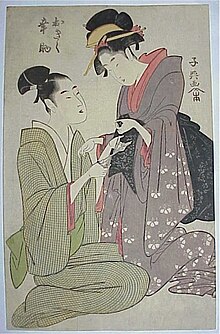Thread play
The Cradle (in German-speaking countries also Abhebespiel , Dieting, weight loss game or witch's called) is a game of skill for one or more persons. Figures are knotted with a closed cord , which are often derived from nature. There are thousands of thread games around the world, mostly figures. The loosening or lifting game is probably the most famous thread game in Central Europe.
history
The original origin of the ancient game can no longer be determined. The probability speaks for a parallel development in different regions of the world, although in some cases similar figures emerged. The oldest known written tradition of a thread game comes from Heraklas from the 1st century. The game scientists Siegbert A. Warwitz and Anita Rudolf point out that a string or thread game was already known in the Middle Ages of the European cultural area, "which was combined with magical powers and called 'Hexenfuß' or 'Drudenfuß'" . It had a magical and ritual meaning. It was used, for example, to conjure up the sunrise and the starry sky and told myths about the beginning of creation. The girls of the Chugach Eskimos preferred to play it in autumn, because they believed they could weave in the rays of the autumn sun and delay the onset of winter. The creation of the braided figures is often accompanied by rhymes or songs in which stories, fairy tales and legends are told. On a woodcut by the Japanese artist Eishōsai Chōki from 1804 (see picture) a thread game can be found, which was named 'cat's cradle'.
At the beginning of the 20th century, the American ethnologist Caroline Augusta Furness-Jayne compiled an extensive collection of games from numerous countries, which was first published in 1906 by Charles Scribner's Sons in New York and reprinted there in 1962 by Dover Publications. To this day, it is the best-known and most detailed documentary on the string figures and the play of threads that are widespread worldwide.
In later times, the ritual-magical meaning increasingly faded and the thread games assumed more and more a useful function such as practicing the skillful use of sewing equipment or knotting harpoon lines , but above all a communicative entertainment role in people's everyday life. The figures were given national names. This is how the 'fishing net' in Micronesia , the 'spider' in Polynesia , the 'leopard skin' in Africa , 'sledge' and 'bear' in the Arctic region , the 'crocodile' in Egypt , the 'kangaroo' in Australia or the ' Effel Tower 'in Europe . The anthropologist P. Georg Bögershausen observed the game of threads in Papua New Guinea and called the parlor game called 'Veveuka', in which all kinds of figures were created by intertwining a string , as a typical "favorite game for girls and women on the Gazelle Peninsula" . With the Aborigines in Australia and the indigenous peoples of Easter Island, the thread games also had a communicative function, as they were made to serve the understanding of the different tribes across language barriers. A photo from the year 1916 from the USA (see picture) documents an Indian woman with the thread play figure 'Bear'.
The cord
Animal tendons, human hair, natural fibers, etc. are used as cords . The most practical, however, is a nylon or cotton cord about 3 mm in diameter. The length depends on the complexity of the figures, but 2 meters is a good guideline.
Playing styles

One player
Usually the thread game is played alone.
figure
It's about using certain techniques to put the thread around your fingers in such a way that a picture emerges at the end. The declarer also uses his teeth or his toes as a “third hand”.
Thread stories
Thread stories are usually told by a single person who uses thread figures to illustrate a story. Thread stories are made up of at least two characters. A figure (picture) from the previous one is played and not started all over again.
Tricks
Here the cord is twisted in an apparently complicated manner, only to be loosened surprisingly. The best known are the unleashing tricks. Other tricks are tying a knot and string through the loop.
Two players
figure
A player makes one or more pieces together with another player. An example of this is the weight loss game .
Tricks
Here the second player usually has a more passive role - either by making a choice or by providing a body part, e.g. B. in unleashing.
More than two players
If there are several players, a longer thread is required for the figure. For example, with a 20 m thread, every 5 people play the 5 fingers of one hand. However, not all figures can be transferred onto large threads.
characters
There are thousands of thread figures worldwide, in almost all peoples. The braided or woven figures have names such as
- Cup and saucer (probably the most famous thread game worldwide)
- Four diamonds (also called diadem; known from America under the name of Jacob's ladder) - this figure is also found on all continents.
- Cat cradle (see weight loss game )
- Harpoon / fish spear
- Boom (boat)
- Maus or Zug (more common in Germany)
- Fighting headhunters
- Witch broom
- bathtub
Special races
Some thread game figures got their names from the peoples who invented them. The thread game is known in many cultures; here is a small selection:
Aboriginal
Tribes with different languages or dialects were able to establish an understanding with the thread figures.
Inuit

The thread game ( Inuktitut : Ajaraarutit ) was also very popular with the Inuit .
Kwakiutl
Among the Kwakiutl Indians , ethnologists found special, frequently used sequences and called them katilluik .
The Navajo Indians are very skilled threadplayers. Ethnologists have therefore dedicated a new expression to them: the Navajo jump. If a lower loop has to be brought over an upper loop on one finger during the thread play, one says: "Do a Navajo!"
Thread games in the film
- Whale Rider : At the beginning of the film, the heroine plays a thread figure in a very short scene.
- the horse Whisperer
- Wanted : At the end of the film, in which a loom plays an important role, a thread figure is played.
String games in literature
- The Roman Cats Cradle by Kurt Vonnegut quotes a nursery rhyme about the cat's cradle cats cradle.
literature
- Caroline Augusta Furness-Jayne: String Figures and How to Make Them , New York 1906, reprinted New York 1962.
- Joost Elffers, Michael Schuyt (ed.): The witch game. Finger thread games rediscovered. DuMont, Cologne 1978, ISBN 3-7701-1024-2 .
- Felix R. Paturi : String figures from all over the world. Hugendubel Verlag, Munich 1988, ISBN 3-88034-378-0 .
- Lothar Walschik: String games are more. 3. Edition. Kallmeyerische Verlagsbuchhandlung, Seelze 2006, ISBN 3-7800-5825-1 .
- Michaela Schwarzbauer, Monika Oebelsberger: Aesthetic competence - just a catchphrase? LIT Verlag, Vienna 2017, page 42.
- Eric Vandendriessche: String Figures as Mathematics? An anthropological approach to string-figure making in oral traditional societies. Springer 2015.
See also
Web links
- Thread play pages of the well-known German old master - instructions and beautiful strings
- English-language site on which many thread play figures are explained with video clips.
Individual evidence
- ↑ Lawrence G. Miller: The Earliest (?) Description of a String Figure . In: American Anthropologist . 1945, p. 461–462 , doi : 10.1525 / aa.1945.47.3.02a00190 ( full text [PDF; accessed on March 23, 2020]).
- ^ A b Siegbert A. Warwitz, Anita Rudolf: Fadenspiele , In: Dies .: Vom Sinn des Spielens. Reflections and game ideas . 4th edition, Verlag Schneider, Baltmannsweiler 2016, ISBN 978-3-8340-1664-5 , p. 123
- ^ Caroline Augusta Furness-Jayne: String Figures and How to Make Them , New York 1906, reprinted New York 1962.
- ^ P. Georg Bögershausen: Anthropos , Nomos Verlagsgesellschaft, Berlin 1915, page 908.
- ↑ Michaela Schwarzbauer, Monika Oebelsberger: Aesthetic competence - just a catchphrase? LIT Verlag, Vienna 2017, page 42.
- ↑ Of threads and thread games. ( Memento from September 9, 2009 in the Internet Archive ) at: aboinudi.de
- ↑ Jean Malaurie: Myth of the North Pole. 200 years of expedition history . National Geographic, 2000, ISBN 3-936559-20-1 , pp. 181 ( limited preview in Google Book search).


